Two Oratories are remarkable in Cadíz - one as the den of
liberal constitutions and the other as perhaps the greatest small
Baroque chapel in Andalusia. We didn't have enough time to see the
former because we spent a lot of time in the latter: The Oratorio of
the Sacred Cave (Oratorio de la Santa Cueva).
Portico
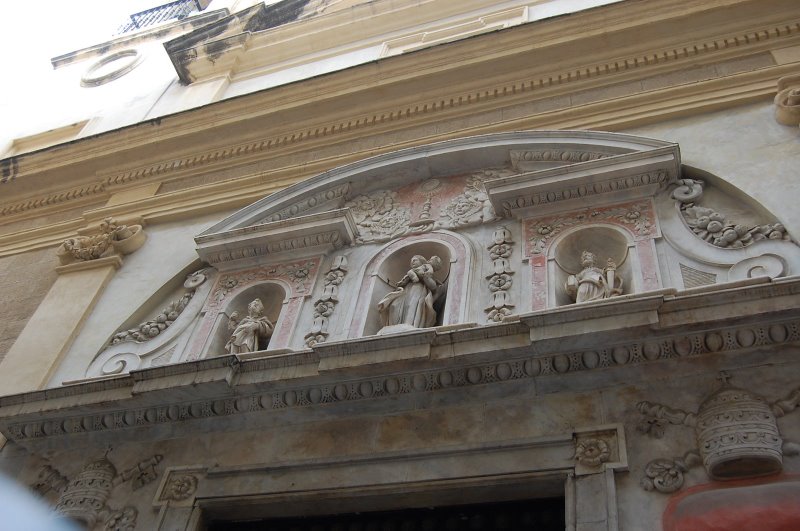
Along streets too narrow to get proper pictures, we found adjacent
religious buildings: the Church of the Holy Rosary and the Oratorio of
the Sacred Cave.
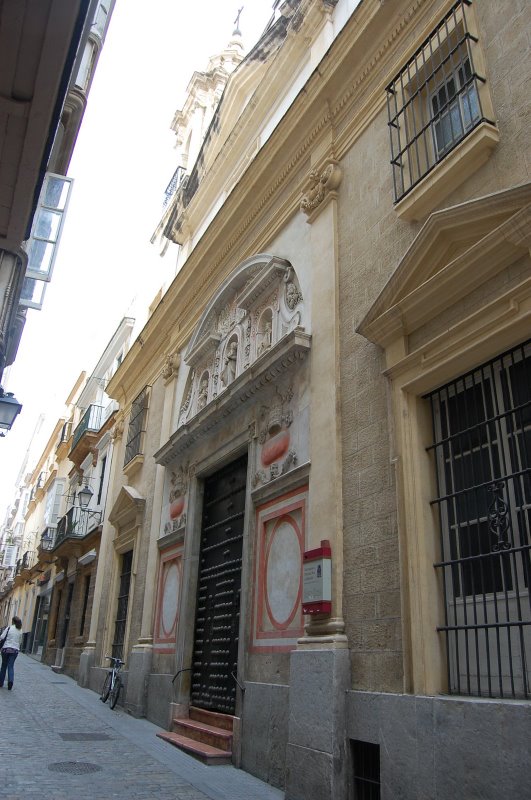
The portico is that of of Holy Rosary church. The Rosary gets special devotion
here as our Lady of the Rosary is the town's patron after saving
Cadíz from the plague twice. Note the papal tiaras and St.
Peter's keys on either side of the door.
(Double click on the picture to enlarge it.)
About the time this church was
built, the bishop established 15 brotherhoods -- one for each mystery
of the Rosary. Members would walk through town chanting the prayers.
Today over 30 brotherhoods drag floats through the streets during
Cadiz's many religious festivals -- some considered the best in Iberia.
Unfortunately the church of the Holy Rosary was closed, but the
extraordinary Oratory
attached to it was open. It's divided into two worship spaces: a
simple lower level with a large sculpture of Calvary and an incredible
Baroque/neo-classic upper chapel that rivals anything near its size in
all of Andalusia.
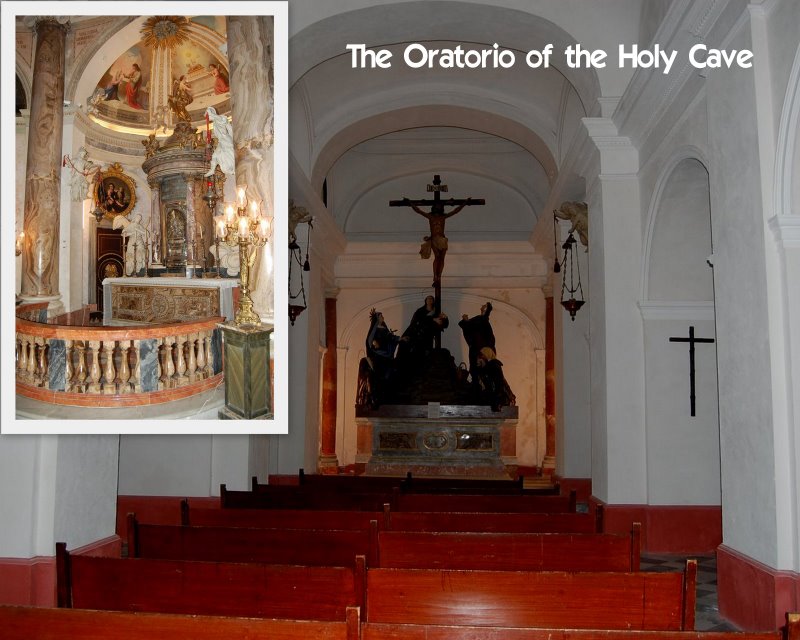
The last word in lower chapel design
Oratories are semi-public churches usually serving as chapels for
specific congregations. For this Oratorio to the Sacred Cave,
the lower chapel is
quite austere and probably devoted to somber spiritual exercises by
novitiates or those making retreats. Both this and the
elaborate upper chapel -- and the Holy Rosary Church next door --
were funded by the generous pocketbook of nobleman Jose Saenz
de Santamaria who's buried here.
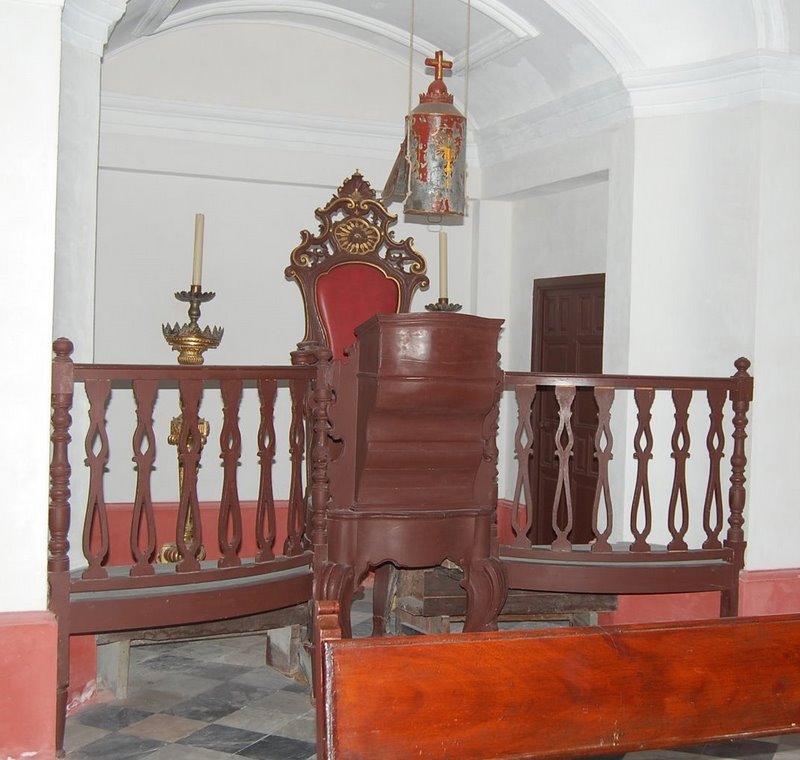
The retreat master's chair and desk
At the rear of the lower chapel is this desk used by the religious
formation master to observe the retreatants and novices during their
spiritual formation.
While the elegant upper chapel is an ellipse, we
have a mundane rectangle-shaped space down below separated into three naves by
heavy pillars bearing the weight of all the inlaid marble which forms
the upper chapel.
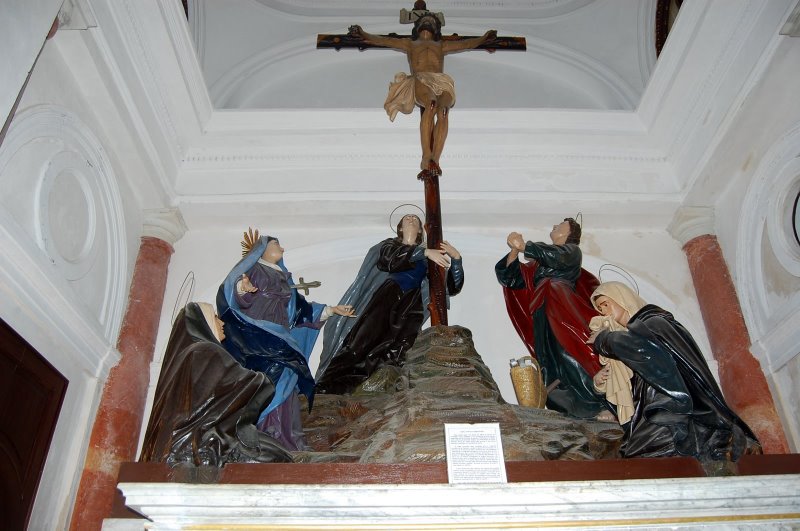
Dominating this lower space is the large neoclassic sculpture of Calvary with
its cross soaring into the dome area. (Pretty good when you can get a dome in the
lower church!) At the carving's feet are torture
implements. (San Ricardo de Cheney watches over these, perhaps). The sculptors include one of many called
Vaccaro.
This sculpture (and a bit of sponsorship) inspired a famous musical connection as well: Joseph Haydn's
famous Oratorio based upon the
Seven Last Words of Christ was commissioned
for this place (and a copy of the original publication is on display in
a mini-museum which uses some of the wider hall spaces.)
Ready for your
weekly quiz: which Gospel contains the seven last words? Answer at the end of this page?
Supposedly retreatants would achieve a stage of contemplation in the
simple chapel below and then would ascend to the upper level into an
exquisite religious space:
The Upper Chapel
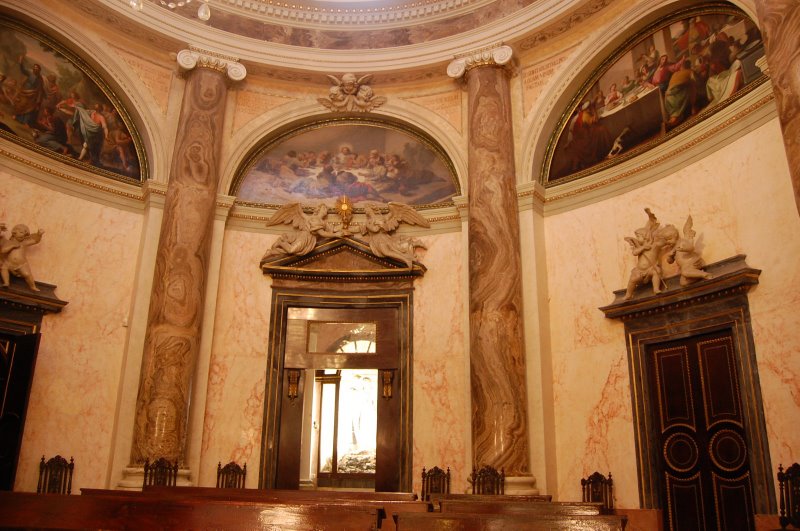
Often we find that the buildings of one or two architects dominate the look
of smaller Andalusian towns. This is especially the case if the place
was wealthy for a fairly short period of time. For Cadíz,
these architects are Torcuato Cayon de la Vega (died 1783) a
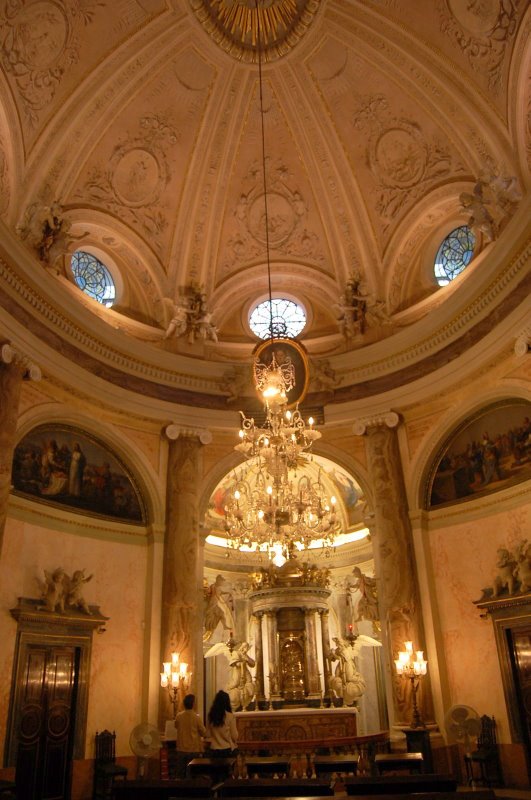
nd his
godson/namesake Torcuato Benjumeda (died 1836). Cayon started out
Baroque but transitioned to the neo-classic architecture which
Benjumeda mastered. This upper chapel of this Oratorio is their masterpiece.
Note the
semicircular lunette paintings between the soaring ionic columns
The two Torcuatos appeared to work well together. Typically the younger
Benjumeda would execute the designs of Cayon de la Vega, meaning the
overall feel would be restrained neo-classic as we have here rather
than the flamboyant Baroque of de la Vega.
Their layout pays homage to Italian master sculptor Gian Lorenzo Bernini.
Bernini's favorite of his architectural works was the elliptical chapel
done for the Jesuit seminary of Sant'Andrea on the Quirinal Hill in
Rome built a century before this oratory.
We couldn't tell what the
Jesuit DNA was in this place, but it's all over the décor.
The choice of Bernini's seminary chapel was not by accident. More on
that later.
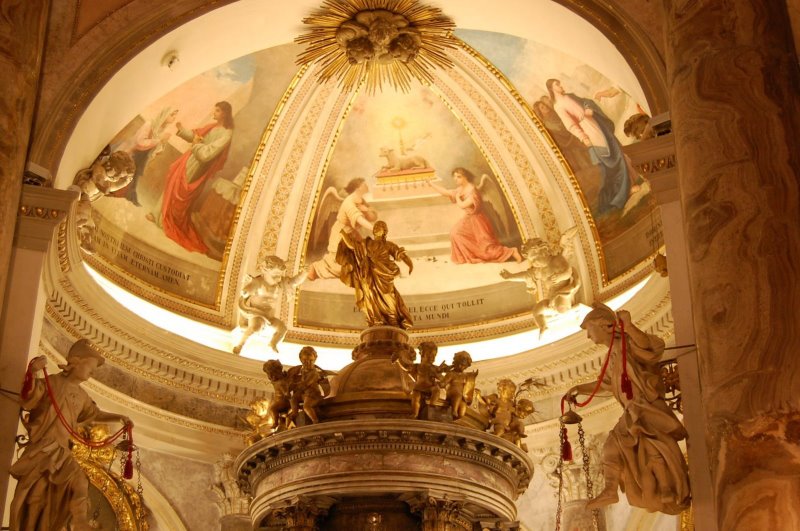
The ionic columns define 6 spaces, one of them recessed into the
elegant tabernacle capped by the ceiling above.
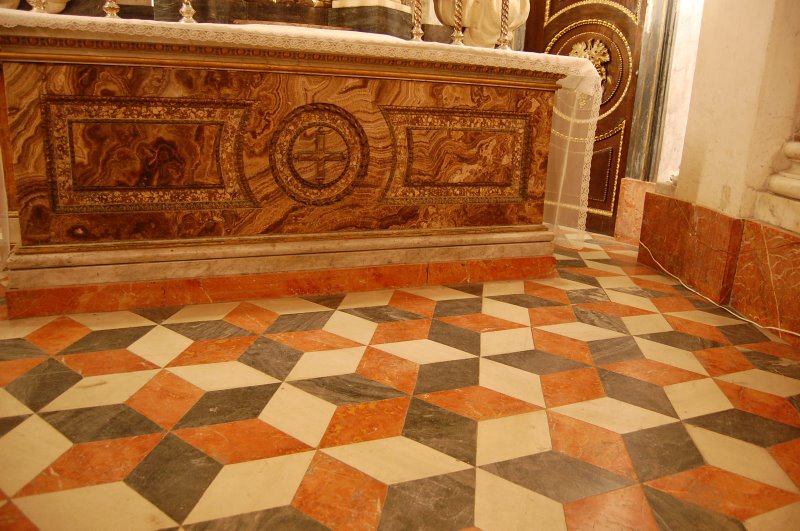
The inlaid multicolored marble floor seems like the type that would
someday inspire M. C.
Escher who was clearly influenced by the Moorish
Alhambra in Granada.
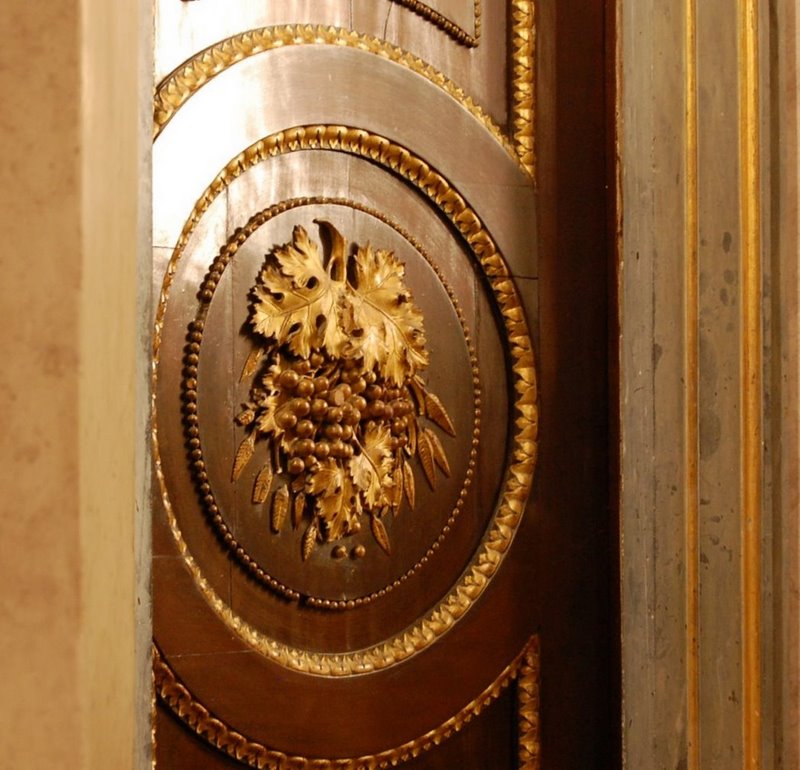
Virtually no detail is left undecorated including this harvest
decoration on the door.
Goya's hand
Five lunettes (three done by Goya in 1795 including the one below of the
Last Supper) circle the walls and complement the altar ceiling.
(Please
forgive the camera shake, these are much better preserved than this
photo suggests.) Already the dominant Spanish painter when he did these
lunettes, Goya became first painter to the King shortly afterward.
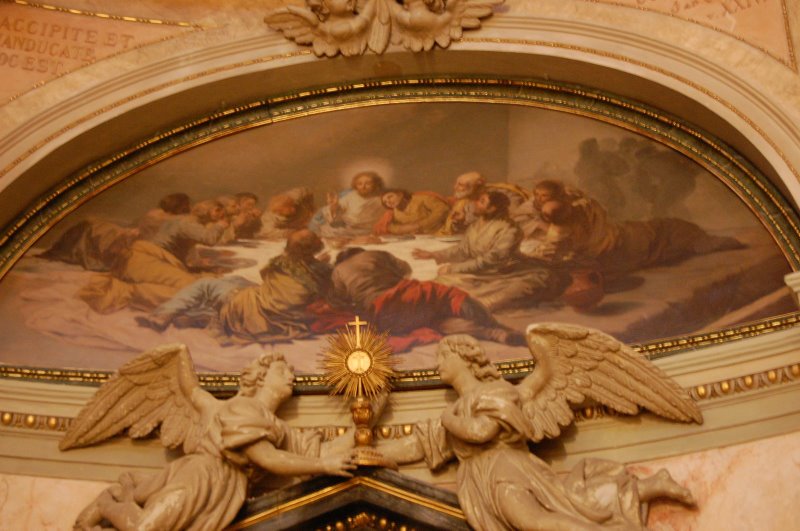
Reliefs of the Young Jesuit Saints
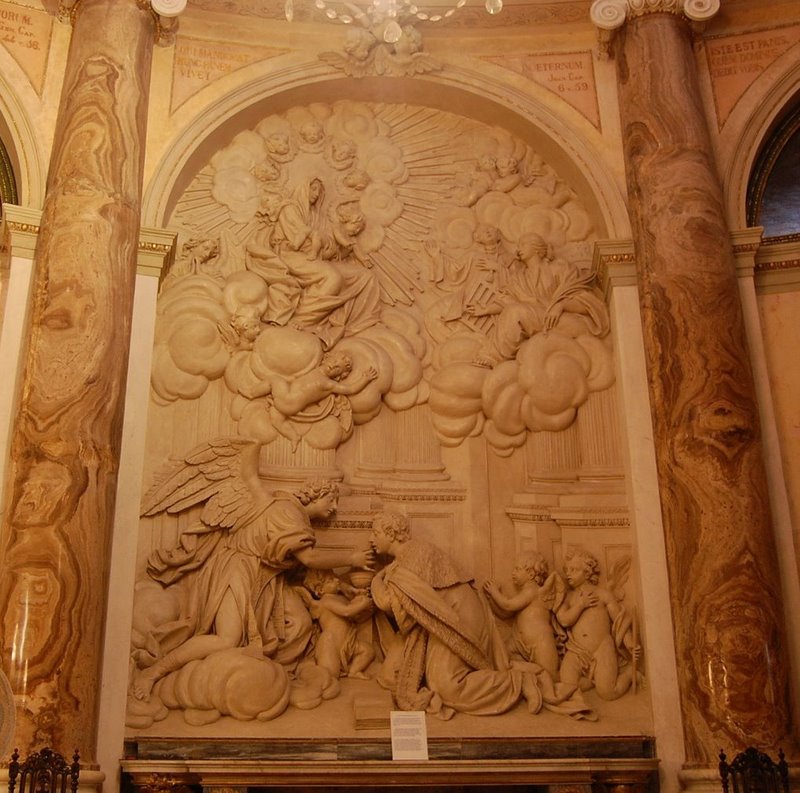
It's hard to tell just what the Jesuit connection is to this place but
besides this spot's overall elliptical design being inspired by the
Jesuit seminary chapel in Rome, each side has an elaborate relief of a
young Jesuit saint receiving communion, perhaps to inspire Jesuit
novices who may have prayed in this space. Above we have Saint
Stanislaus Kostka, a Jesuit novice who died at age 18. This image
recalls how Saint Barbara brought angels to give Kostka communion when
he was sick. Although the son of wealth, Kostka walked the 1500 miles
from his native Poland to enroll at the Jesuit seminary in Rome. In the
top portion, we have Mary and Jesus at left and Saint Barbara and Saint
Lawrence (on whose feast Kostka died) at right.
Another communion relief is shown below:
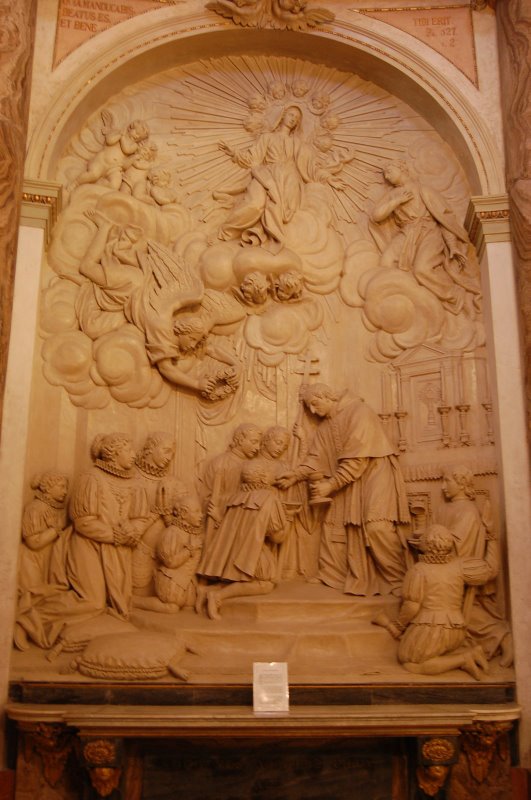
These high reliefs are the work of sculptor Cosme Velasquez Merino
(1755 --1837). Born in Madrid, Velasquez became head of the sculpture
department of Cadíz's art academy. Above we see the
first communion of another young Jesuit -- Saint Louis (or Aloysius)
Gonzaga who also joined the Society at Sant'Andrea. He died while
ministering to victims of the plague in 1591. He was 23.
Here he
receives communion from another Jesuit saint, Charles Borromeo.
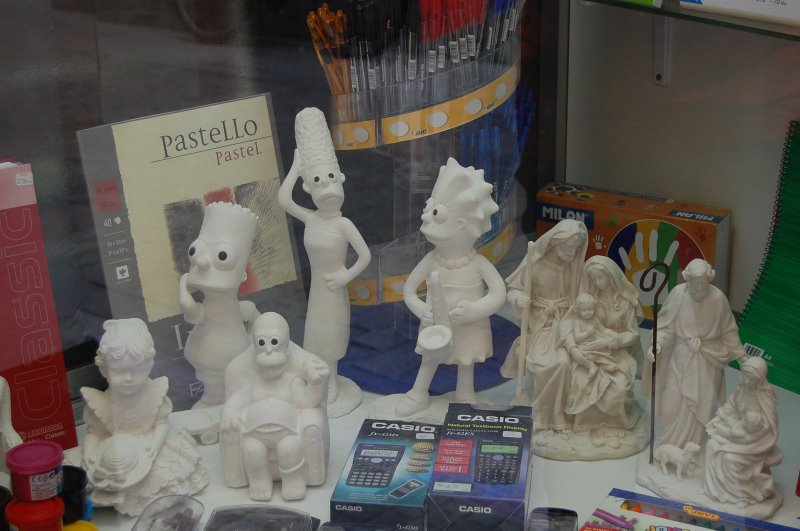
Gonzaga
is dressed in the lower section as the noble he was but wears the
Jesuit novice cassock at upper right as Mary receives him into heaven.
So ends our visit of this exquisite chapel.
And now for something completely different. After leaving the
neo-classical jewel of the Oratory, we found this shop window across
the street selling both religious and secular sculpture.
ANSWER TO THE
QUIZ: It was a trick question, the Seven Last Words (really sentences) were compiled from all
four Gospels.
|
Please join us on the following slide show to give
Cadíz the viewing it deserves by clicking here.
|
|
Previous: Cadíz Cathedrals Next: A Walk through Old Town Cadíz
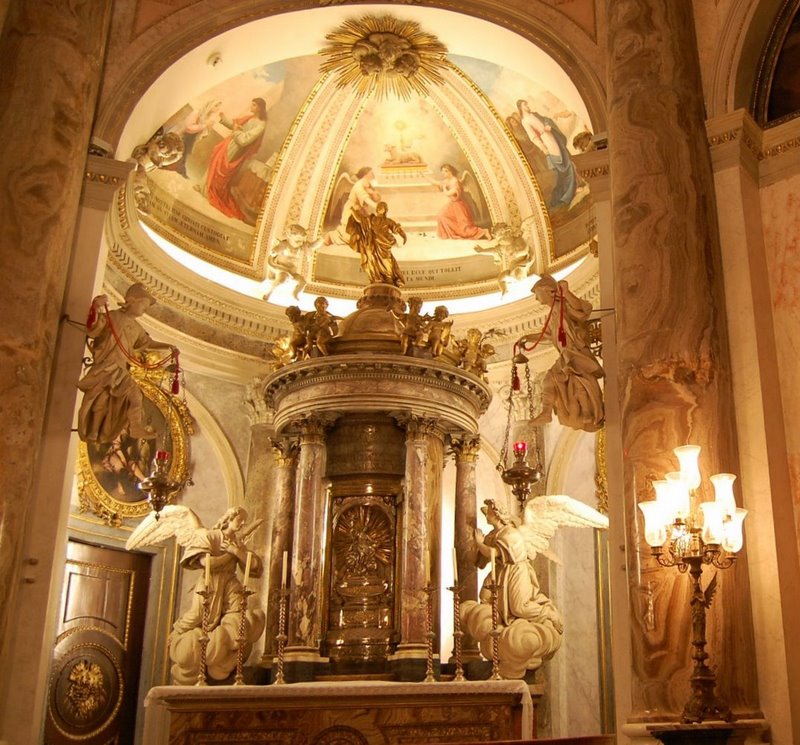







 nd his
godson/namesake Torcuato Benjumeda (died 1836). Cayon started out
Baroque but transitioned to the neo-classic architecture which
Benjumeda mastered. This upper chapel of this Oratorio is their masterpiece.
nd his
godson/namesake Torcuato Benjumeda (died 1836). Cayon started out
Baroque but transitioned to the neo-classic architecture which
Benjumeda mastered. This upper chapel of this Oratorio is their masterpiece.

 Virtually no detail is left undecorated including this harvest
decoration on the door.
Virtually no detail is left undecorated including this harvest
decoration on the door.



 Gonzaga
is dressed in the lower section as the noble he was but wears the
Jesuit novice cassock at upper right as Mary receives him into heaven.
So ends our visit of this exquisite chapel.
Gonzaga
is dressed in the lower section as the noble he was but wears the
Jesuit novice cassock at upper right as Mary receives him into heaven.
So ends our visit of this exquisite chapel.
